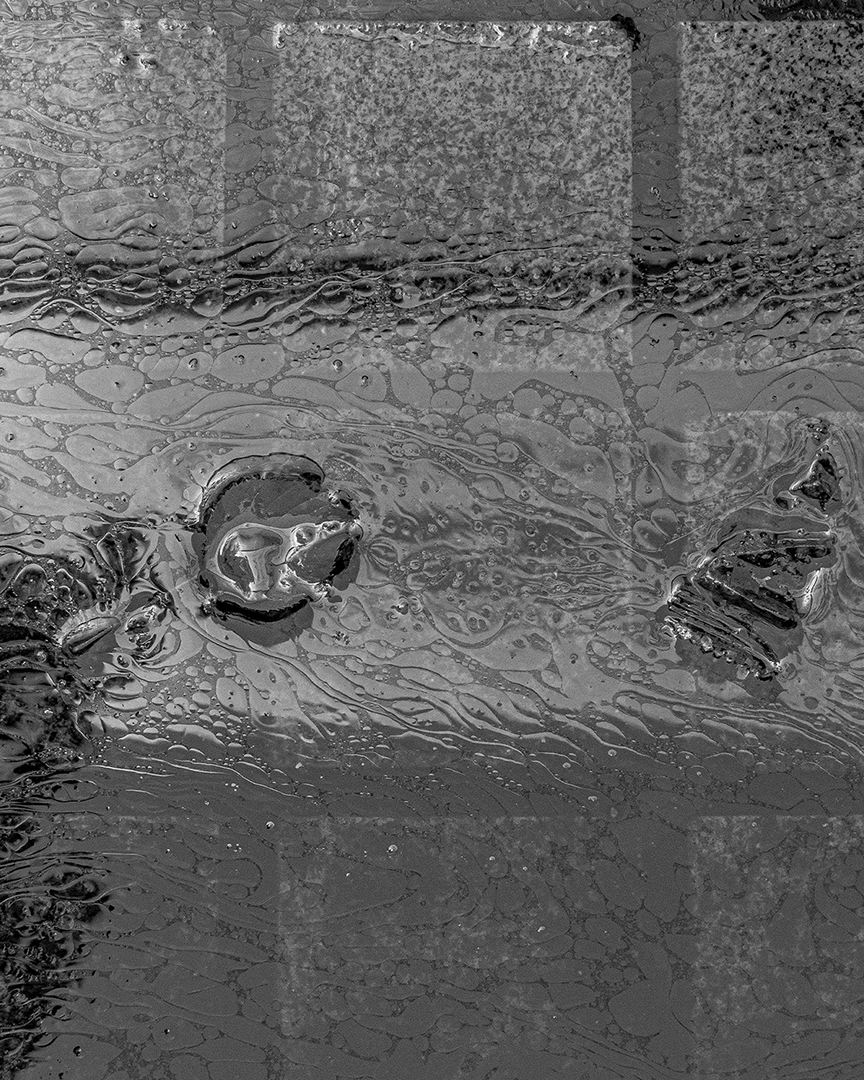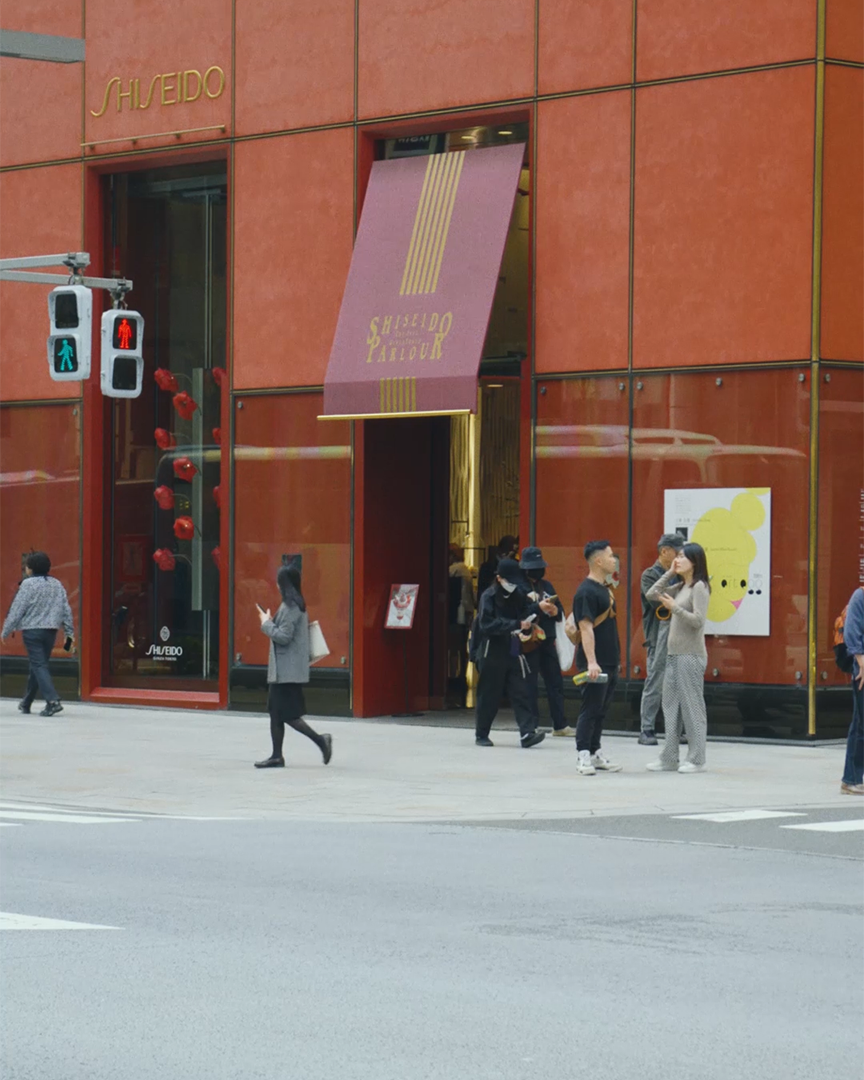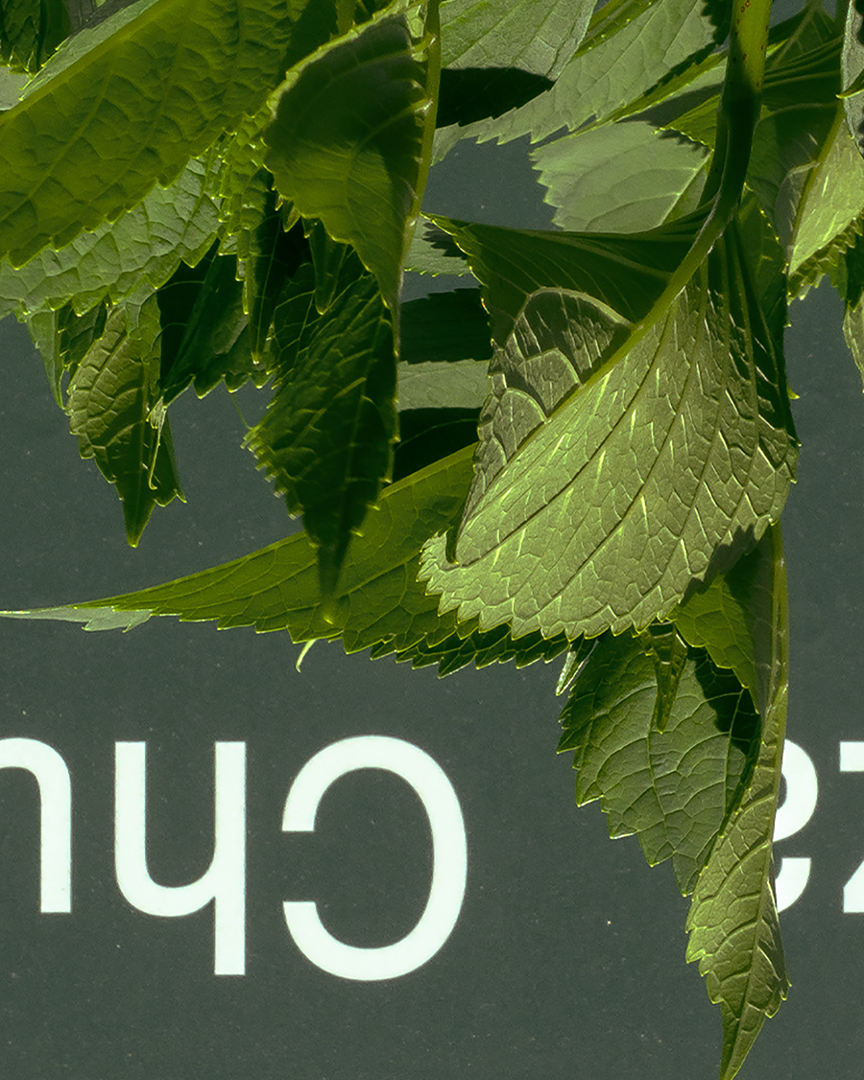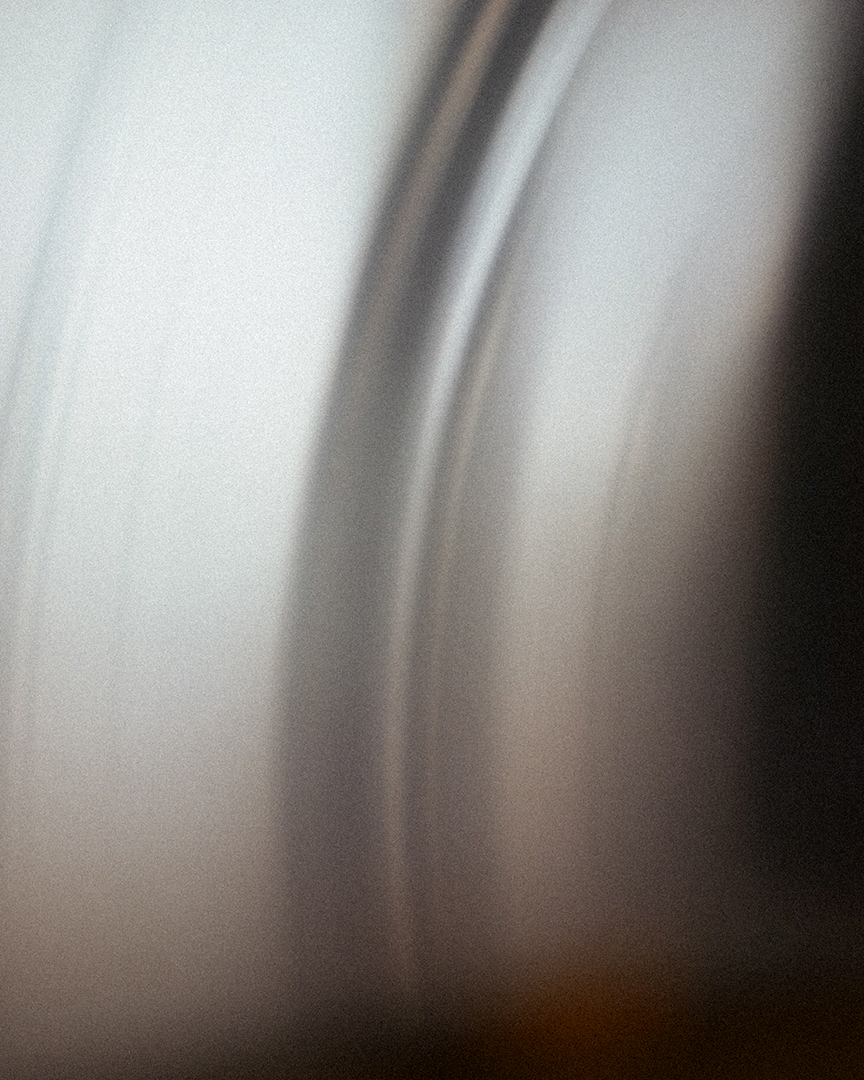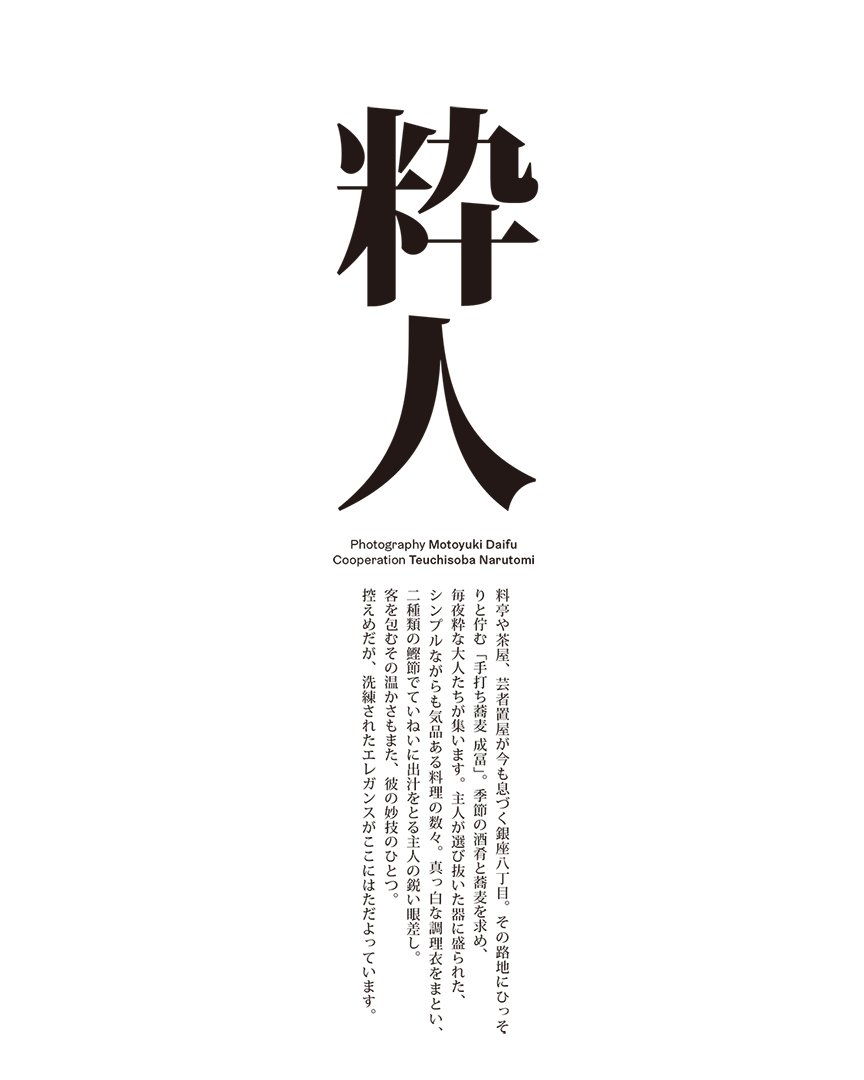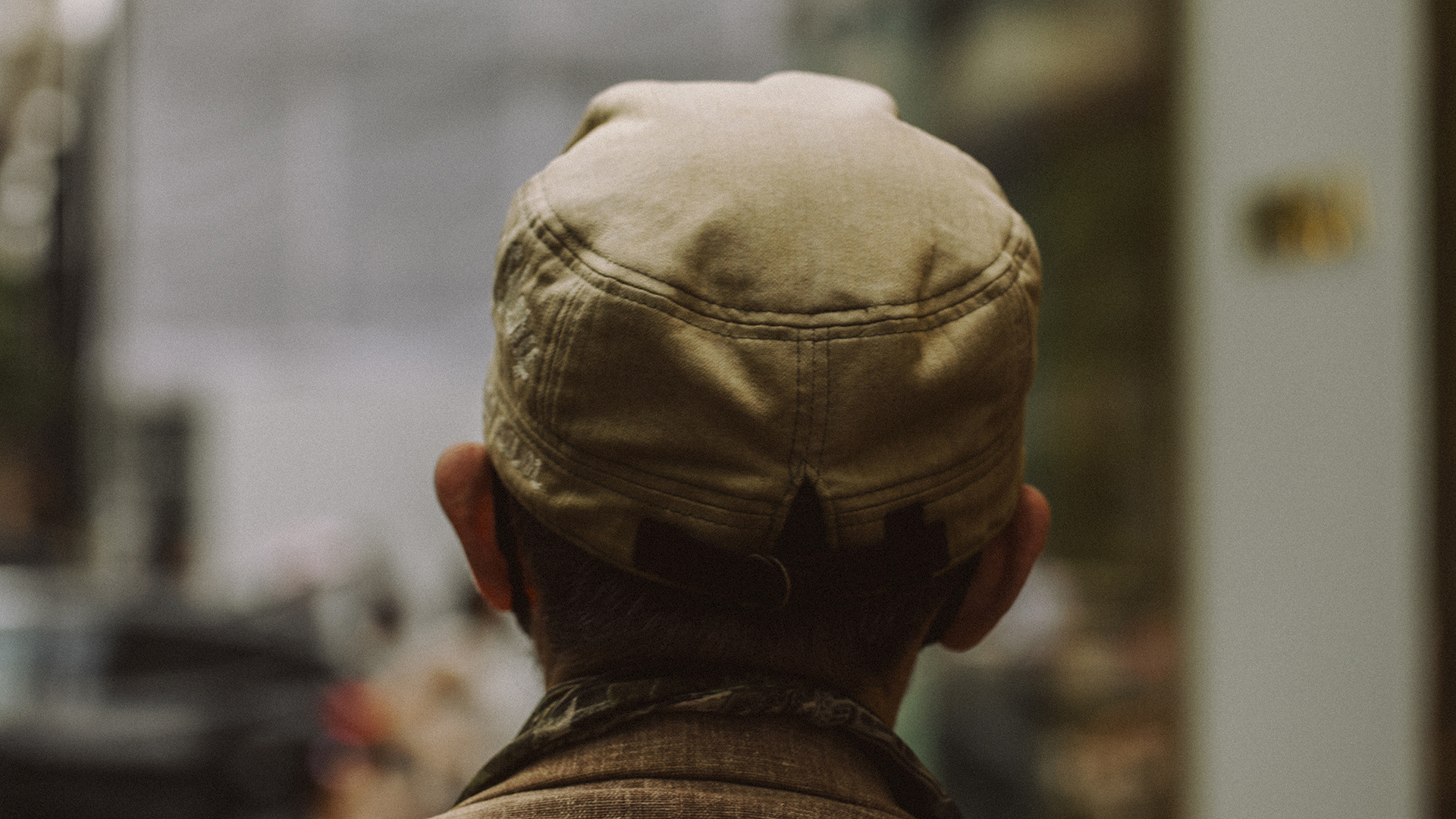
銀座――この魅力的な街は、多くの人々にとって、特別な瞬間や記憶に残る場所となっています。親に手を引かれて足を踏み入れたデパート、マスターのこだわりを感じる喫茶店、初デートで訪れたレストラン。どれもが、この街の独特の雰囲気と結びついています。
連載「銀座・メモワール」では、森岡書店代表、森岡督行さんがナビゲーターとして登場します。多様なゲストが織りなす銀座の豊かな物語を共有し、銀座の多面性とその普遍的な魅力に焦点を当てます。連載を通じて、銀座の隠れた魅力と多彩なストーリーに触れ、新たな価値を一緒に発見しましょう。
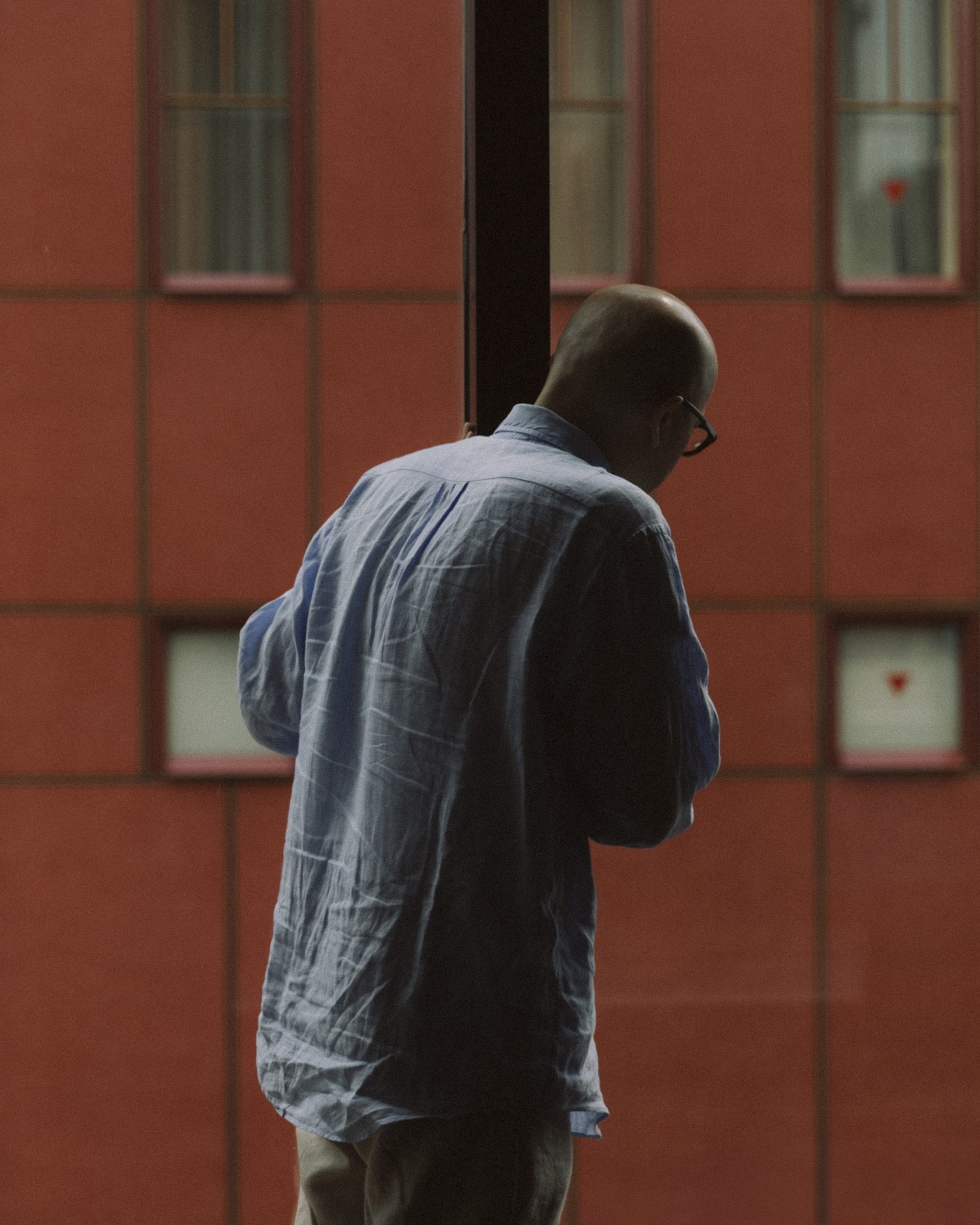
連載5回目のゲストは、現代詩人の吉増剛造さんです。詩作を中心に写真や映像、朗読パフォーマンスといった幅広い創作をおよそ70年にわたり続けてきた吉増さんですが、最初のキャリアは美術出版社・三彩社の編集者でした。銀座の大栄会館にあった三彩社に勤務していた編集者時代から半世紀。詩人になった今では、お気に入りのカフェで執筆するため日課のように銀座に通っています。フランク・ロイド・ライト建築の路地性、現代詩花椿賞の授賞式、公私で交流のあった写真家たち。全身を通じて詩作をする吉増さんが語る銀座の思い出は、アーティストや街の身体性にまつわるものでした。
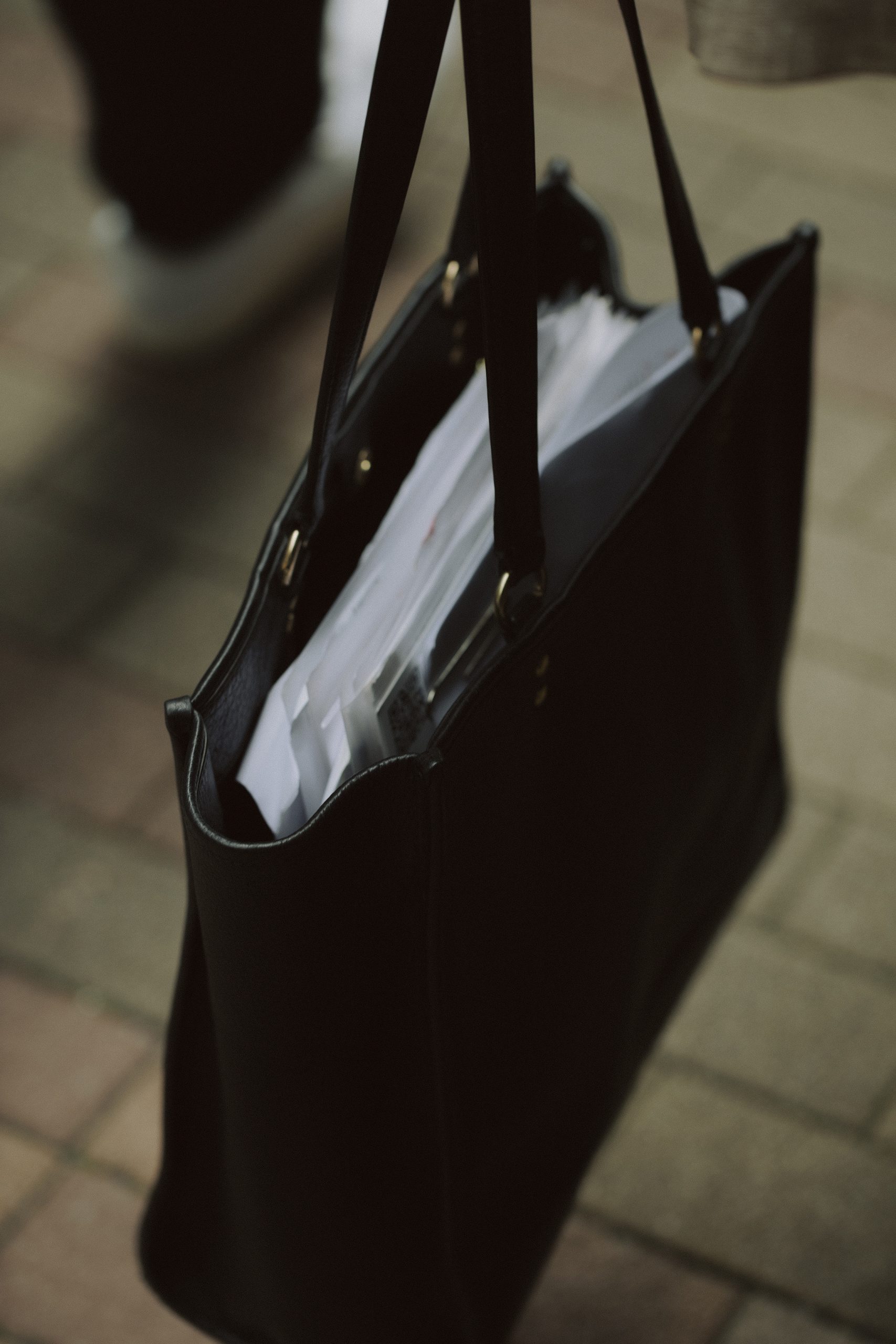
フランク・ロイド・ライトの旧帝国ホテル、アントニン・レーモンドの教文館
森岡 学生の頃から銀座に来る機会は多かったのでしょうか。
吉増 慶應の文学部は1年生が日吉で、僕の場合はドイツ語を落っことして2年、だから10代の後半は遊ぶ場所といえば渋谷でした。だけど、慶早戦があって慶應が勝つと銀座に流れるわけじゃないですか。
森岡 慶應の学生は慶早戦の後に交詢社のなかにあるビアホールでビールを飲んでいたっていう逸話を聞いたことがあります。吉増さんも大学時代に行かれていたのでしょうか。
吉増 学生のときは入る資格がないから、その周りにいました。交詢社に行くようになったのは「三田文学」の理事長をやってた頃。推薦者が2人必要ですから。入れてもらってからずいぶん変わりましたけどね。交詢社は銀座のへそだなあ。でもさっき大栄会館に行ってきたけど、銀座は道が全く変わらずに残っていますね。ビルもそう。教文館のビルもアントニン・レーモンドさんの建築でしょう。彼の師匠筋にあたるフランク・ロイド・ライトの追っかけをやってた時期があって、そのときに知ったんだけど。
森岡 ライトの追っかけをされていたんですか⁉
吉増 うん。友達が結婚式をやったのがね、旧帝国ホテルだったの。そのとき、ライトの建築に肌で触れた感じがして驚いちゃって。洞窟にみんなで身を寄せ合うような、そういう感覚。フランク・ロイド・ライトの建築に入ったときのセンセーションというのは驚くべきものがありましたね。
その後、ニューヨークのグッゲンハイム美術館で朗読会があったんだけれども、朗読してると聞いてる人がものすごく近くにいる感じがするの。これはやっぱり、ライトの天才性だなと思って。それからグッゲンハイムは、野の道の外れみたいなところに小さなトイレがあるんだ。ウサギかネズミが入っていきそうな小道の先に。その感覚っていうのはすばらしいものでね。で、レーモンドさんのトイレのつくり方もちょっと似ていて、教文館もトイレの場所がいいんだよなあ。路地みたいなところに、ひっそりとある。中上健次(1)の路地とはまた違うけれども、僕たちが街に対してもっている愛着の芯みたいなものは、銀座に残っている「路地性」にあると思う。
森岡 資生堂の前名誉会長、福原義春さんも慶應出身だと思いますけど、交流がおありだったのですか?
吉増 僕が第2回現代詩花椿賞の受賞者で、福原さんはまだ常務だったけれど、授賞式でご挨拶しましたね。ワインのおいしいのが出たなあ(笑)。文学賞で100万円も副賞が出たんです。
森岡 受賞作は『オシリス、石ノ神』ですね。100万円というと当時ではまとまったお金だと思いますが、どのようにお使いになりましたか?
吉増 ロサンゼルスにいたマリリアさん(奥様)に、ホンダシビックを買いました。ちょうど100万円。それも受賞の挨拶のときに言ったら、冷やかされたけど(笑)。
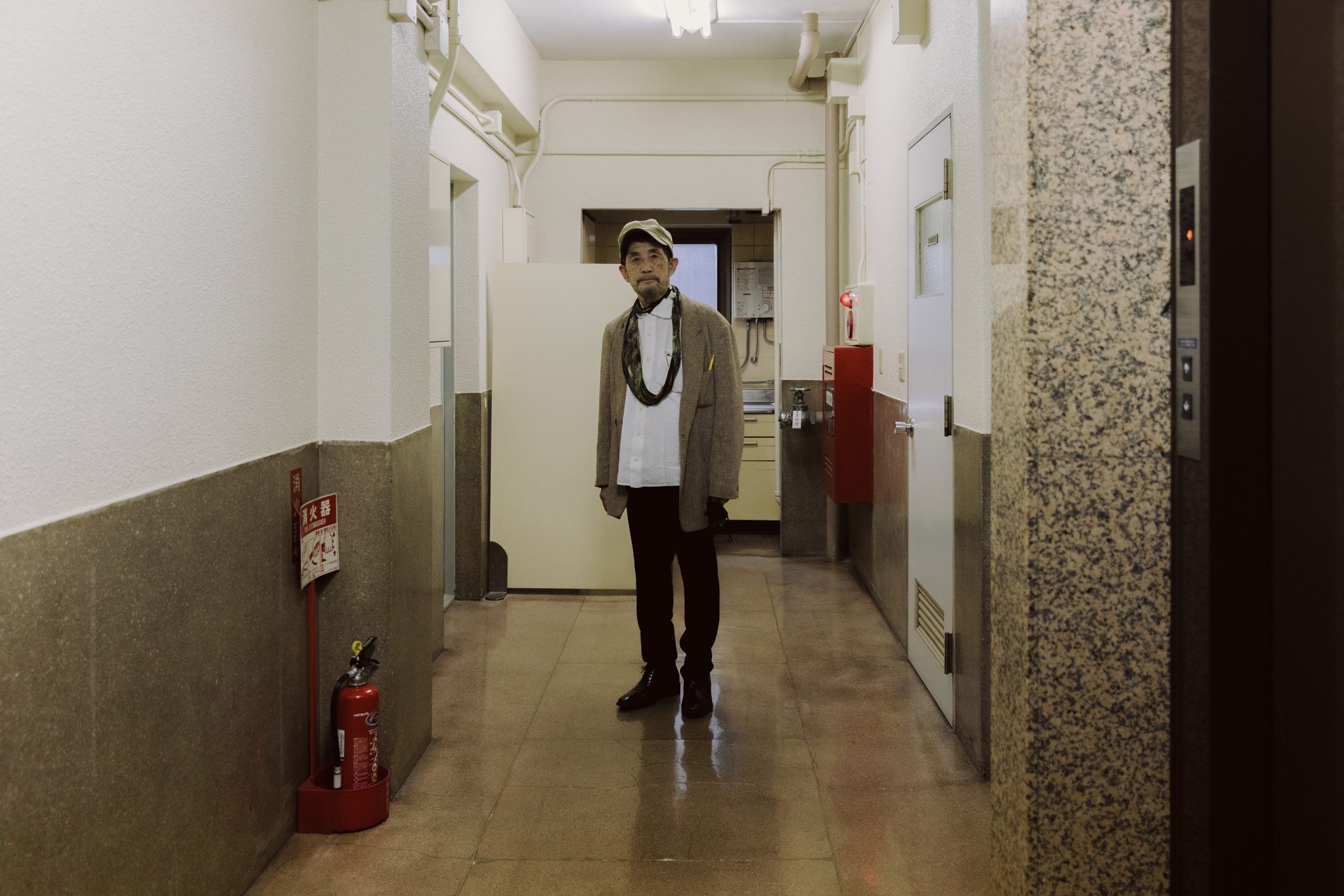
大栄会館と編集者時代
森岡 大栄会館にあった三彩社にお勤めになっていた時期がある、ということですが、そこではどのようなお仕事をされていたんですか?
吉増 美術雑誌『三彩』の編集者でしたからね。慶應の文学部を卒業した後、渋谷にあった国際情報社で『国際写真情報』の編集者になったんだけれども、ケンカしてすぐに辞めて、新聞広告に出ていた三彩社の求人募集を見て応募して、それが1963年か64年だったかな。そこから6年間、大栄会館の6階に通いました。さっき撮影で行ったけど、空き部屋でそのまんまでしたね。テナントも岩手日報が残ってた。あの辺は元々、新聞社の支社が多いところだけれど、そういう感じはいまだに残ってたなあ。
森岡 1963、1964年というと東京オリンピックの頃ですから、日本デザインセンターですとかライトパブリシティとか、デザイナーやクリエイターが銀座に集まっていた時期ではないかなと思うのですが、銀座でそうした方々とお会いされることはあったんでしょうか。
吉増 そう言われてみたら、『花椿』の写真を担当していらしたんだろうな、資生堂の編集室に横須賀功光さん(2)をお訪ねした覚えがあるなあ。『Provoke』の前身にあたる写真批評雑誌『フォト・クリティカ』の編集者の柳本尚規さんに横須賀功光論を書け、と言われて。
森岡 それは読んでみたいです。
吉増 取材に行くと、横須賀さんが僕の周りをぐるぐる回りだしたんですよ。びっくりしちゃった。写真家だからそうなのかな、と思ったけれども。周りをぐるぐる回られるというのは人に出会うときの珍しいショックだったなあ(笑)。
森岡 滅多にない出会いだと思います(笑)。

吉増 三彩社にいたときも、ずいぶんいろんな依頼をしましたね。それこそ、花田清輝(3)に頼んだり、宮川淳(4)や大岡信(5)に頼んだり。毎日現代美術展かなんかの特集の大事なエッセイは花田清輝に頼んだかな。東松照明(6)さんにも寄稿してもらいましたね。東松さんがよかったんだあ。よかったっていうけど、会いに行くのが楽しかった(笑)。写真家に会いに行くのが楽しいって、なんだろうな。高梨豊(7)とかアラーキー(荒木経惟)(8)なんかと付き合うのは、その後だったな。写真家とは、ずいぶん付き合いがありましたね。写真が好きだったし、写真家になりたかったし。
森岡 高梨さんは、写真集でいうと『都市へ』(1974年、イザラ書房)『町』(1977年、朝日新聞社)の頃ですよね。荒木さんは電通に勤められていた時期ですか?
吉増 うん。その頃はまだ電通。キッチンラーメンって食堂があったね。あそこでよく展覧会をやってたよね。
森岡 東松照明さんには撮影ではなく、原稿を依頼したんですか?
吉増 そう。南画廊の「ティンゲリー展」だったかなあ、すごい文章を書いてもらった。まあ、銀座は画廊ばっかりで、毎日のように展覧会があったからさ。
森岡 東松さんはもう沖縄を撮っていた時期ですか?
吉増 そのときは『太陽の鉛筆』(1975年、毎日新聞社)なんかをやってた。その前に『サラーム・アレイコム』(1968年、写研)というアフガニスタンを撮った写真集があって。あれもいいんだ。それから、地面に埋め込まれている古い釘やなんかを撮った「アスファルト」という最初期の写真があってね。星雲みたいに見えるんだけど、東松さん自身に聞いたら、食い詰めて、どうしようもなくなって品川かなんかを歩いているときに、駅の地下道みたいなところに釘やなんかが埋まってるアスファルトを見つけたらしい。都市の隠れた傷みたいなものをメタフィジックに撮る東松さんがとっても好きでね。東松さんの思い出も、僕自身の銀座体験とぶつかってる感じもするなあ。そのおかげで、亡くなるまで沖縄まで訪ねて行ったりして、懐いてましたけどねえ。だから、ずいぶんそういう接触は多かった。それも三彩社で雑誌をやってたときの大きな思い出ですね。
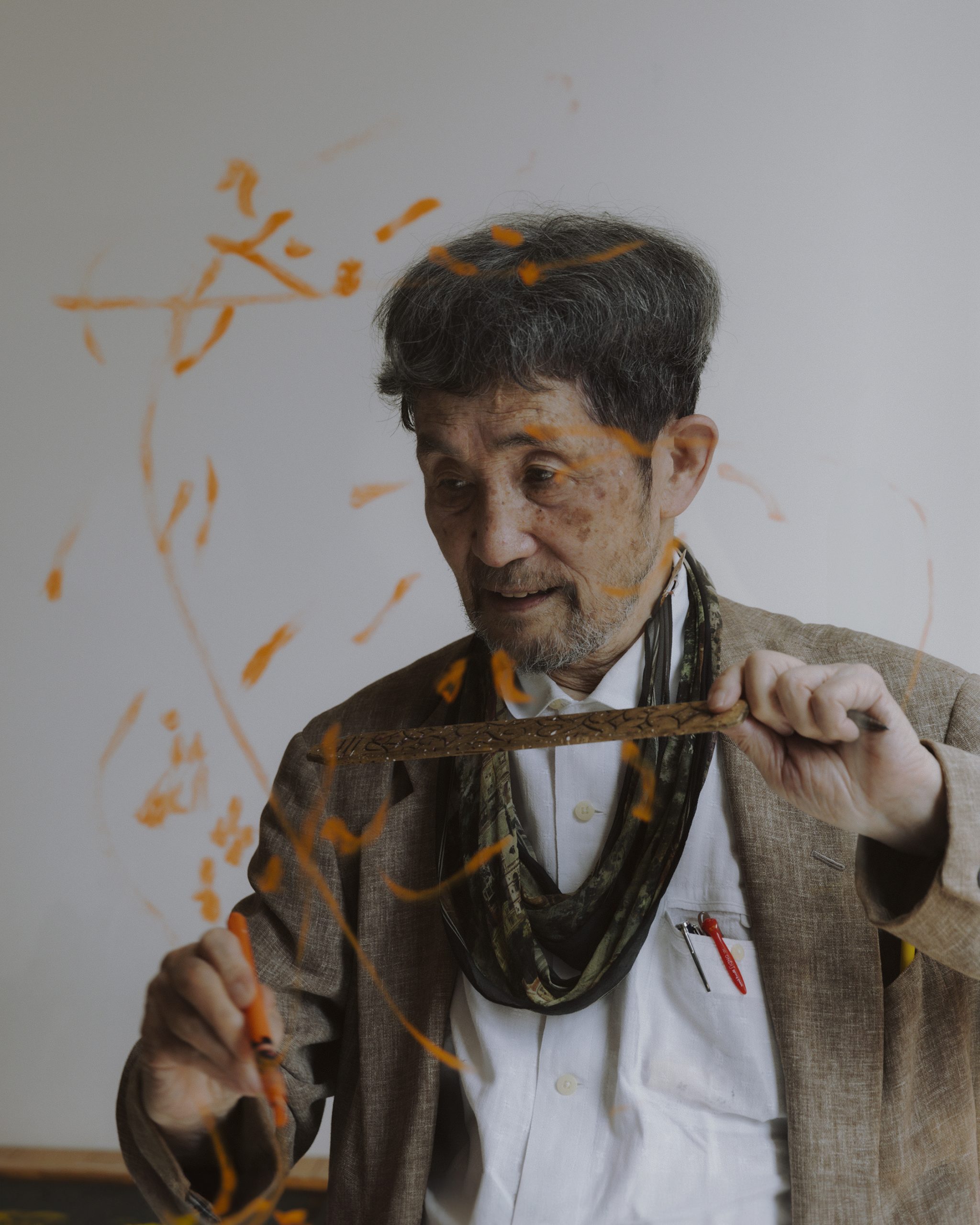
吉増 剛造
1939年東京都生まれ。慶應義塾大学国文科卒。在学中より詩作を始め、64年、第一詩集『出発』を刊行。詩集に『黄金詩篇』(高見順賞)『オシリス、石ノ神』(第2回現代詩花椿賞)『「雪の島」あるいは「エミリーの幽霊」』(第49回芸術選奨文部大臣賞)『Voix』(1回西脇順三郎賞)など著作多数。『DOMUS X』(コトニ社)を2024年に出版。詩作以外にも東京国立近代美術館の「声ノマ全身詩人吉増剛造展」や松濤美術館の「声ノマ全身詩人吉増剛造展」、七里圭監督作品の『背』に主演するなど活動は多岐に渡る。
森岡 督行
1974年山形県生まれ。森岡書店代表。文筆家。『800日間銀座一周』(文春文庫)、『ショートケーキを許す』(雷鳥社)など著書多数。 キュレーターとしても活動し、聖心女子大学と共同した展示シリーズの第二期となる「子どもと放射線」を、2023年10月30日から2024年4月22日まで開催する。
https://www.instagram.com/moriokashoten/?hl=ja平岩壮悟
編集者/ライター1990年、岐阜県高山市生まれ。フリーランス編集/ライターとして文芸誌、カルチャー誌、ファッション誌に寄稿するほか、オクテイヴィア・E・バトラー『血を分けた子ども』(藤井光訳、河出書房新社)をはじめとした書籍の企画・編集に携わる。訳書にヴァージル・アブロー『ダイアローグ』(アダチプレス)。
www.instagram.com/sogohiraiwaナタリー・カンタクシーノ
フォトグラファー
スウェーデン・ストックホルム出身のフォトグラファー。東京で日本文化や写真技術を学び、ファッションからドキュメンタリー、ライフスタイルのジャンルで活躍。https://www.instagram.com/nanorie/
Ginza Memoir #5 Part 1 Gozo Yoshimura "The Alleyway Spirit of the Imperial Hotel"
2024.10.17
Text / Sogo Hiraiwa
Photo / Nathalie Cantacuzino
Ginza is a fascinating town, frequently linked with special moments and fond memories. Visits to department stores while holding tightly to a parent’s hand, afternoons in old-fashioned cafés run by one-of-a-kind characters, first dates in special restaurants . . . Ginza is a place like no other.
Hanatsubaki’s “Ginza Memoir” series, hosted by Yoshiyuki Morioka of the iconic Morioka Shoten bookstore, explores the multifaceted nature and universal appeal of Ginza through interviews with guests from a wide variety of fields. With Morioka as guide to Ginza’s hidden charms and diverse narratives, new discoveries await around every corner.
Our guest for the fifth instalment of “Ginza Memoir” is contemporary poet Gozo Yoshimasu. For more than seventy years, Yoshimasu has pushed creative boundaries not just in poetry but also in fields such as photography, video art, and recital performance, but his career began with an editorial position at arts publisher Sansaisha. Half a century has passed since Yoshimasu commuted daily to Sansaisha’s offices in the Ginza Daiei Kaikan building, and he still visits Ginza almost daily to write in his favourite cafes. In this interview, he discusses the alley-like characteristics of Frank Lloyd Wright’s architecture, unexpected encounters at the ceremony where he received the Hanatsubaki Contemporary Poetry Award, and professional and private associations with photographers. Yoshimasu writes his poetry with his whole body, and his memories of Ginza, too, reflect the corporeal experience of a true artist-about-town.
Frank Lloyd Wright’s Imperial Hotel and Antonin Raymond’s Kyobunkwan Building
Morioka: Were you a frequent visitor to Ginza in your student days?
Yoshimasu: First-year students at Keio’s Faculty of Letters had classes on the Hiyoshi campus. I failed German, so I was at Hiyoshi for two years, and Shibuya remained my stomping ground throughout the latter half of my teens. That said, when Keio beat Waseda at baseball, we were swept out to Ginza too.
Morioka: I’ve heard stories about Keio students drinking in the Kojunsha Club’s beer hall after a Keio–Waseda game. Did you go as a college student, too?
Yoshimasu: Students weren’t allowed inside, but I was in the general area. I started visiting the Kojunsha properly when I was chair of [literary magazine] Mita Bungaku. You need two sponsoring members to get in. The club has changed a great deal since then, though. It’s the omphalos of Ginza. That said, I visited the Daiei Kaikan earlier, and the Ginza streets around it are completely unchanged. The buildings, too. The Kyobunkwan building is by Antonin Raymond, I believe—I knew him back when I was a devoted fan of his teacher Frank Lloyd Wright.
Morioka: You were a devoted fan of Frank Lloyd Wright?!
Yoshimasu: Yes. A friend of mine held their wedding ceremony at the Imperial Hotel, you see. I felt as if I were in direct contact with the architecture, which was a startling experience—as if we were all gathered together in a cave. The sensation of entering a Frank Lloyd Wright building was astonishing.
Later, when, I held a recitation at the Guggenheim Museum in New York, I noticed how incredibly close the people listening felt. This is Wright’s genius, I thought. The Guggenheim has these little restrooms that are at the end of a sort of path through the fields—a narrow path like one a mouse or rabbit might take. The sensibility is just wonderful. Raymond’s approach to restrooms was similar, and the restrooms at the Kyobunkwan building are superbly located as well—quietly hidden at the end of a sort of alley. I think the core of the affection we feel for Ginza has to do with the “alley-ness” of the place—very different from the “alleyways” that Kenji Nakagami1 wrote about, of course.
Morioka: Shiseido’s former honorary chairman Yoshiharu Fukuhara also went to Keio. Did you know him at all?
Yoshimasu: When I received the second Hanatsubaki Contemporary Poetry Award, Fukuhara greeted me at the ceremony. He was still Executive Director then. I remember there was some great wine served, and the prize money was a million yen.
Morioka: You won that award for Osiris, the God of Stone, I believe. One million yen was a lot of money at the time. How did you spend it?
Yoshimasu: I bought a Honda Civic for [my wife] Marilia in Los Angeles. It cost exactly a million yen. People made fun of me when I mentioned that in my acceptance speech!
Editing in the Daiei Kaikan Building
Morioka: You worked for the publisher Sansaisha in the Daiei Kaikan building. What did that position involve?
Yoshimasu: Well, I was an editor for the art magazine Sansai. After I graduated from Keio University, I was hired as an editor for The International Graphic, which was published by Kokusai Johosha in Shibuya, but I got into a fight there and quit almost immediately, then answered a “Help wanted” ad from Sansaisha that I found in the newspaper. That was 1963 or 1964, I think. I spent the next six years working on the fifth floor of the Daiei Kaikan. When we went there earlier for the photography shoot, the empty room was just as I left it. Even the Iwate Nippo was still there as a tenant. A lot of newspapers originally had branches in that area—maybe there’s still something of that in the air?
Morioka: 1963 or 1964 would have been the lead-up to the Tokyo Olympic Games. I imagine designers and creators were gathering in Ginza at the Nippon Design Center, Light Publicity, and so on. Did you meet any people like that?
Yoshimasu: Now that you mention it, I do remember visiting Noriaki Yokosuka2 at the Shiseido editorial office. I suppose he was in charge of photography for Hanatsubaki. Naoki Yanagimoto, who was chief editor of Foto Critica, the photography criticism magazine that preceded Provoke, told me to write about him.
Morioka: I’d like to read that.
Yoshimasu: When I went to interview Yokosuka, he started walking around me in circles. That was a surprise. I wondered if it was because he was a photographer. Being circled was a rare kind of shock to experience when meeting someone!
Morioka: It does sound like an unusual first encounter.
Yoshimasu: I gave out all kinds of assignments myself when I was at Sansaisha. I assigned work to Kiyoteru Hanada,3 Atsushi Miyakawa,4 Makoto Ooka5 . . . As I recall, I had Kiyoteru Hanada write an important essay for a special on the Mainichi Contemporary Art Exhibition or something like that. Shomei Tomatsu6 was another contributor. He was a great guy—by which I mean, visiting him was a lot of fun! Why are photographers so much fun to be around? I didn’t start hanging around with Yutaka Takanashi7 or Nobuyoshi Araki8 until later. I’ve always spent a lot of time with photographers. I like photography, and I wanted to be a photographer myself.
Morioka: That would have been about the time of Takanashi’s collections Towards the City (1975, Izara Shobo) and Town (1977, Asahi Shinbunsha). Was Araki still working at Dentsu then?
Yoshimasu: Right, he was still at Dentsu. There was a diner called Kitchen Ramen where he often held exhibitions.
Morioka: And you assigned Shomei Tomatsu as a writer rather than a photographer?
Yoshimasu: That’s right. I think it was for the Tinguely exhibition at the Minami Gallery. He turned in an amazing piece. Ginza was full of galleries, and there were exhibitions practically every day.
Morioka: Was Tomatsu already shooting Okinawa then?
Yoshimasu: He was working on The Pencil of the Sun (1975, Mainichi Shinbunsha). Before that he published Salaam Alaikum (1968, Shaken), a collection of photographs of Afghanistan. That was fine work. There was also “Asphalt,” one of his earlier photographs, showing old nails and things stuck in the ground. It looked like a nebula. According to Tomatsu, he said that when he was starving and at the end of his rope, he was walking in Shinagawa or somewhere when he saw the asphalt and nails in a tunnel under a train station. I really liked Tomatsu’s metaphysical approach to capturing the hidden wounds of the city like that. My memories of Tomatsu seem to jostle against my own Ginza experiences, in a way. I was fond of him—before he died, I even went to visit him in Okinawa. I had a lot of contacts like that. That’s another major memory from my time at Sansaisha.
Gozo Yoshimasu
Born 1939, Tokyo. Graduate of Keio University’s Faculty of Literature. Began writing poetry while still in school, publishing his first collection Departure in 1964. His other collections include Anthology of Golden Age Poetry (Jun Takami Prize), Osiris, the God of Stone (Second Hanatsubaki Contemporary Poetry Award), and “The Island of Snow,” or “The Ghost of Emily.” In 2024, he published Domus X (Kotonisha). He has been the subject of exhibitions like the National Museum of Modern Art, Tokyo’s The Voice Between: The Art and Poetry of Yoshimasu Gozo and the Shoto Museum of Art’s The Echoes from the Abyss: The Poems of Gozo Yoshimasu, as well as director Kei Shichiri’s film ‘Se’-Back.Yoshiyuki Morioka
Born 1974 in Yamagata. Head of the Morioka Shoten bookstore. Writer. Published books include Around Ginza in 800 Days (Bunshun Bunko) and Forgiving the Shortcake (Raichosha). Also active as an art curator, with recent shows including Children and Radiation, the second stage of an exhibition held jointly with the University of the Sacred Heart (October 30, 2003–April 22, 2024).
https://www.instagram.com/moriokashoten/?hl=jaSogo Hiraiwa
Editor/writer
Born 1990 in Takayama, Gifu. Freelance editor and writer contributing regularly to literary, cultural, and fashion magazines. Also involved in planning and editing books, including the Japanese edition of Octavia E. Butler’s Bloodchild and Other Stories (trans. Hikaru Fujii). Translator of Virgil Abloh’s Dialogues (Adachi Press).
https://www.instagram.com/sogohiraiwa/Nathalie Cantacuzino
Photographer
Born in Stockholm, Sweden. Studied Japanese culture and photographic technique in Tokyo. Shoots in genres ranging from fashion to documentary and lifestyle.
https://www.instagram.com/nanorie/

